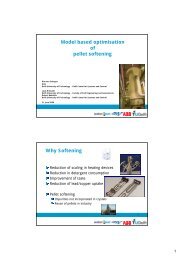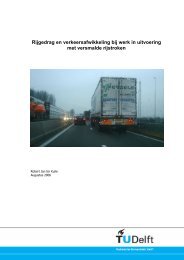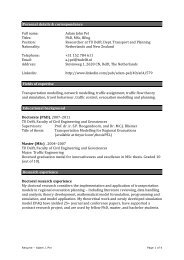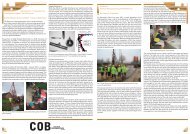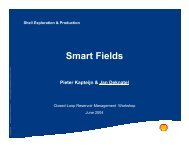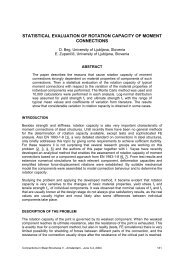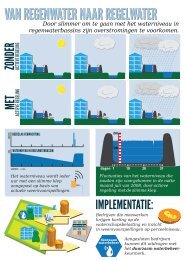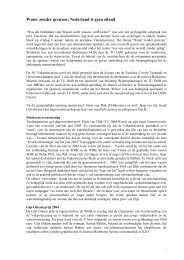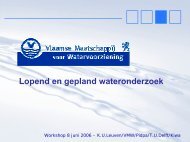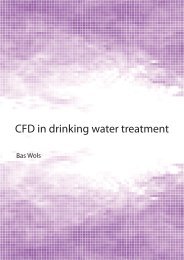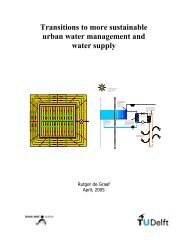Research on pedestrian traffic flow in the Netherlands - TU Delft
Research on pedestrian traffic flow in the Netherlands - TU Delft
Research on pedestrian traffic flow in the Netherlands - TU Delft
You also want an ePaper? Increase the reach of your titles
YUMPU automatically turns print PDFs into web optimized ePapers that Google loves.
Daamen, W, & Hoogendoorn, SP (2003). <str<strong>on</strong>g>Research</str<strong>on</strong>g> <strong>on</strong> <strong>pedestrian</strong> <strong>traffic</strong> <strong>flow</strong>s <strong>in</strong> <strong>the</strong> Ne<strong>the</strong>rlands. In<br />
Proceed<strong>in</strong>gs Walk 21 IV (pp. 101-117). Portland, Oreg<strong>on</strong>, United States: Walk 21 c<strong>on</strong>ference.<br />
predicts <strong>the</strong> effect of worsen<strong>in</strong>g c<strong>on</strong>diti<strong>on</strong>s <strong>on</strong> <strong>flow</strong> behavior. Note that also a dynamic<br />
assignment model versi<strong>on</strong> has been developed <strong>in</strong> which it is assumed that <strong>pedestrian</strong>s <strong>in</strong><br />
choos<strong>in</strong>g <strong>the</strong>ir routes have perfect <strong>in</strong>formati<strong>on</strong> <strong>on</strong> current and future travel c<strong>on</strong>diti<strong>on</strong>s (i.e.<br />
c<strong>on</strong>sider<strong>in</strong>g actual walk<strong>in</strong>g times).<br />
Walker model<strong>in</strong>g<br />
In NOMAD, <strong>pedestrian</strong>s are described <strong>in</strong> terms of a closed feedback c<strong>on</strong>trol system. Their<br />
model, which is similar to o<strong>the</strong>r models that have been proposed to describe <strong>the</strong> executi<strong>on</strong> of<br />
human c<strong>on</strong>trol tasks, naturally leads to an optimal c<strong>on</strong>trol formulati<strong>on</strong>, where <strong>pedestrian</strong>s are<br />
assumed to m<strong>in</strong>imize <strong>the</strong> predicted costs of walk<strong>in</strong>g. These costs are determ<strong>in</strong>ed by am<strong>on</strong>g<br />
o<strong>the</strong>r th<strong>in</strong>gs <strong>the</strong> extent to which <strong>pedestrian</strong>s can walk at <strong>the</strong>ir desired velocity, <strong>the</strong> proximity<br />
of o<strong>the</strong>r <strong>pedestrian</strong>s, walk<strong>in</strong>g near to obstacles, and <strong>the</strong> need to accelerate or decelerate.<br />
Fur<strong>the</strong>rmore, it is hypo<strong>the</strong>sized that <strong>the</strong> costs are discounted over time, imply<strong>in</strong>g that events<br />
<strong>in</strong> <strong>the</strong> near future are deemed more important than events that are expected to happen much<br />
later. Besides a c<strong>on</strong>trol model, predict<strong>in</strong>g <strong>the</strong> optimal walk<strong>in</strong>g behavior of a <strong>pedestrian</strong>, a<br />
physical model describes <strong>the</strong> effects of physical c<strong>on</strong>tact between <strong>pedestrian</strong>s and obstacles.<br />
NOMAD predicts <strong>the</strong> effects of special <strong>in</strong>frastructure <strong>on</strong> <strong>the</strong> walk<strong>in</strong>g speeds of <strong>pedestrian</strong>s.<br />
In case of stairs or grades, <strong>the</strong> desired speed of <strong>the</strong> <strong>pedestrian</strong>s is reduced <strong>in</strong> accordance with<br />
<strong>the</strong> grade of <strong>the</strong> walk<strong>in</strong>g surface or <strong>the</strong> stairs. The behavior <strong>on</strong> an escalator is described <strong>in</strong> a<br />
simplified manner by assum<strong>in</strong>g that <strong>the</strong> <strong>pedestrian</strong> moves at <strong>the</strong> same speed as <strong>the</strong> escalator.<br />
Ma<strong>the</strong>matical descripti<strong>on</strong> of route choice<br />
NOMAD models <strong>the</strong> dest<strong>in</strong>ati<strong>on</strong> area and route choice by assum<strong>in</strong>g that <strong>pedestrian</strong>s jo<strong>in</strong>tly<br />
optimize <strong>the</strong> subjective utility of <strong>the</strong>se choices, where utility depends <strong>on</strong> <strong>the</strong> utility of<br />
perform<strong>in</strong>g an activity at a certa<strong>in</strong> activity area, and <strong>the</strong> access route costs. In turn, <strong>the</strong>se<br />
costs depend <strong>on</strong> <strong>the</strong> preferences and <strong>the</strong> physical capabilities of <strong>the</strong> <strong>pedestrian</strong>s. The route<br />
costs are am<strong>on</strong>g o<strong>the</strong>r th<strong>in</strong>gs determ<strong>in</strong>ed by <strong>the</strong> walk<strong>in</strong>g time, walk<strong>in</strong>g at uncomfortable<br />
speeds, attractiveness of <strong>the</strong> walk<strong>in</strong>g envir<strong>on</strong>ment, and <strong>the</strong> proximity of obstacles (walls,<br />
etc.). As menti<strong>on</strong>ed earlier, routes are c<strong>on</strong>t<strong>in</strong>uous functi<strong>on</strong>als <strong>in</strong> <strong>the</strong> walk<strong>in</strong>g space. In <strong>the</strong><br />
NOMAD model, routes are not c<strong>on</strong>sidered explicitly; ra<strong>the</strong>r, <strong>the</strong> velocities that c<strong>on</strong>stitute <strong>the</strong><br />
optimal route (or ra<strong>the</strong>r, <strong>the</strong> optimal trajectory) are determ<strong>in</strong>ed.<br />
The NOMAD model is activity based. Activities can often be performed at multiple<br />
dest<strong>in</strong>ati<strong>on</strong> (or activity) areas D j . For <strong>in</strong>stance, a ticket can be bought at multiple ticket<br />
counters. The preferred dest<strong>in</strong>ati<strong>on</strong> area depend will depend <strong>on</strong> <strong>the</strong> current locati<strong>on</strong> of <strong>the</strong><br />
<strong>pedestrian</strong>, and thus of <strong>the</strong> cost of gett<strong>in</strong>g to <strong>the</strong> respective dest<strong>in</strong>ati<strong>on</strong> areas. Fur<strong>the</strong>rmore,<br />
dest<strong>in</strong>ati<strong>on</strong>-area specific costs can be def<strong>in</strong>ed that describe <strong>the</strong> preference of perform<strong>in</strong>g an<br />
activity at <strong>on</strong>e dest<strong>in</strong>ati<strong>on</strong> area over ano<strong>the</strong>r.<br />
The NOMAD model allows for <strong>the</strong> def<strong>in</strong>iti<strong>on</strong> of activity sequences: <strong>pedestrian</strong>s might first<br />
buy a tra<strong>in</strong> ticket, subsequently buy a newspaper, and f<strong>in</strong>ally catch a tra<strong>in</strong>. To correctly<br />
describe <strong>the</strong> path choice and dest<strong>in</strong>ati<strong>on</strong> area choice <strong>in</strong> case of activity sequences, <strong>the</strong><br />
term<strong>in</strong>al costs are modified accord<strong>in</strong>gly.<br />
112



